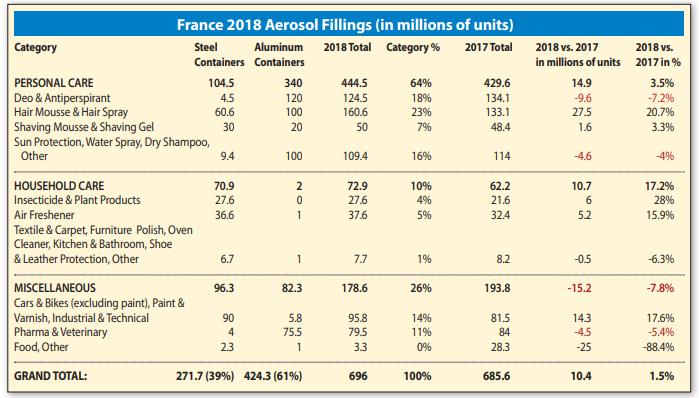France has shown moderate growth in a mature aerosol market 2018
Aerosol production in France remains good in 2017
November 26, 2021France aerosol filling cans amount has slightly declined 2019
November 26, 2021According to Comit é Fran ç AIS des a é rosols (French aerosol commission or CFA), the total number of aerosol products in France in 2018 was 696 million. This is an increase of 10.4 million (1.5%) over 685.6 million in 2017.
Based on mature markets, filling activities in France were stable in 2018, despite significant losses in the food sector. The results are based on data provided by CFA members and non members. Personal care the total amount of personal care aerosols increased by 3.5% to 444.5 million. Deodorant and antiperspirant: the filling amount in 2018 was – 7.2%, and the secondary subclass of personal care aerosol decreased slightly, which was consistent with the trend in previous years. According to CFA, the reasons for the decline in production are:
• disappearance of brand owners
• new products that do not meet consumer expectations
• competition from roll on
• actively promote non French aerosol products in the French market
Mousse and hair gel: the filling volume increased by 20.7% in 2018, which may be due to the large-scale transfer of production to France in 2018. Shaving foam and shaving gel: +3.3% filling volume in 2018, this part is a moderately growing mature market.

CFA said that compared with shaving foam and gel, the new trendsetter fashion trend is more conducive to barber care products. Dry cleaning shampoo and water spray increased slightly in 2018, but did not counteract the decline in sunscreen products. In 2018, the total number of home care increased by 17% to 72.9 million units.
Air fresheners: the filling volume increased by 16.3% in 2018, and air fresheners recorded the strongest growth in recent years. In 2018, many large retailers launched their own brand air fresheners. It is expected that more products will enter the commercial stage in 2019.
Despite some negative media attention, air fresheners have won the favor of consumers. In 2018, the filling amount of horticultural insecticides increased by 28%, and the growth of horticultural insecticides was the strongest. There are two possible reasons:
• for the first time in France, spray horticultural insecticide products.
• rising temperatures and weather changes (e.g. continuous rainfall in summer 2018) may increase the demand for pesticides.
